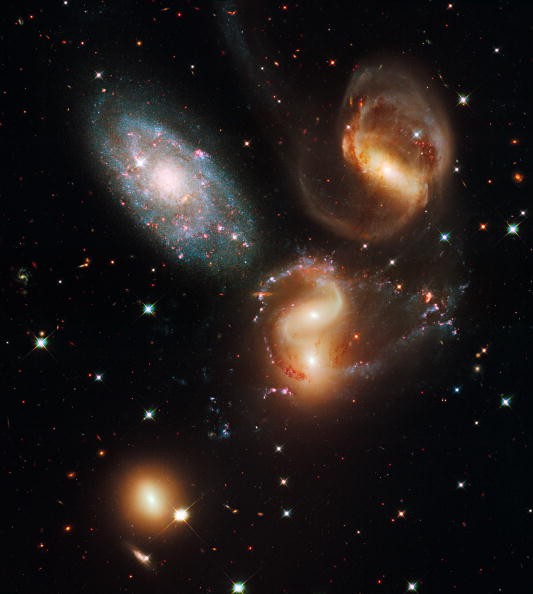Hubble Space Telescope Interesting Find: 4 Galaxies Including Galactic Cannibal Snap
| KJ Belonio | | Jun 22, 2015 03:14 AM EDT |
(Photo : Getty Images/NASA) This 2015, the Hubble Space Telescope captured four galaxies clustered together including a galactic cannibal. The galactic quartet, which were snapped all in on shot, are illuminating brightly deep in space.
Twenty-five years after being launched into space, the Hubble Space Telescope proves it is doing well as it continues to send stunning shots of the galaxy. And on June 18, the telescope showed four interesting galaxies, all in one shot.
Like Us on Facebook
The Hubble Space Telescope, which has traveled more than three billion miles along a circular low Earth orbit, is a project of international cooperation between NASA and the European Space Agency (ESA). It was launched on April 24, 1990, on the space shuttle Discovery from Kennedy Space Center in Florida. It is considered as one of the most productive scientific instruments ever built.
With a measurement of 13.3 meters, the Hubble has peered back into the very distant past to locations more than 13.4 billion light-years from Earth. And this 2015, Benchmark Reporter revealed the telescope captured four galaxies clustered together including a galactic cannibal. The galactic quartet is illuminating brightly deep in space.
"They shine brightly with their glowing golden centers and wispy tails of gas, set against a background dotted with much more distant galaxies," a Hubble spokesperson stated.
According to a release, the cosmic quartet - NGC 839, NGC 838, NGC 835 and NGC833 - is part of Hickson Compact Group 16, which comprises a total of seven galaxies. The Weather Network has learned that these seven galaxies in cluster fall into three categories: Starbursts, LINERs (Low-Ionization Nuclear Emission-line Regions) and Seyfert 2 galaxies.
As described, Starbursts produce new stars at higher rates than other galaxies. While LINERs contain heated gas at their cores that explode with radiation. The Seyfert 2 galaxies, on the other hand, have very bright cores when observed on non-visible wavelengths and have super-massive black holes. However, the Hubble said the cluster may even have been more numerous in the distant past.
"Hickson Compact Groups in particular, as classified by astronomer Paul Hickson in the 1980s, are surprisingly numerous, and are thought to contain an unusually high number of galaxies with strange properties and behaviours," Hubble stated in a release. "HCG 16 is certainly no exception. The galaxies within it are bursting with dramatic knots of star formation and intensely bright central regions."
Aside from the Hickson Compact Group 16, which is not unique in the universe, the Hubble Space Telescope has also captured a galactic cannibalism. As reported by Mashable, NGC 839 shows signs of galactic cannibalism since its shape suggests that it merged with another galaxy not too long ago, whereas the NGC 833 indicates that it may have its gas stripped by galaxy interactions at some point in its history.
While it is common to come across groups like Hickson Compact Groups, the newfound galaxies captured by the Hubble Space Telescope can be quite bizarre.
TagsHubble Space Telescope, Galaxy, outer space, Universe, Black Holes, Science
©2015 Chinatopix All rights reserved. Do not reproduce without permission
EDITOR'S PICKS
-

Did the Trump administration just announce plans for a trade war with ‘hostile’ China and Russia?
-

US Senate passes Taiwan travel bill slammed by China
-

As Yan Sihong’s family grieves, here are other Chinese students who went missing abroad. Some have never been found
-

Beijing blasts Western critics who ‘smear China’ with the term sharp power
-

China Envoy Seeks to Defuse Tensions With U.S. as a Trade War Brews
-

Singapore's Deputy PM Provides Bitcoin Vote of Confidence Amid China's Blanket Bans
-

China warns investors over risks in overseas virtual currency trading
-

Chinese government most trustworthy: survey
-

Kashima Antlers On Course For Back-To-Back Titles
MOST POPULAR
LATEST NEWS
Zhou Yongkang: China's Former Security Chief Sentenced to Life in Prison

China's former Chief of the Ministry of Public Security, Zhou Yongkang, has been given a life sentence after he was found guilty of abusing his office, bribery and deliberately ... Full Article
TRENDING STORY

China Pork Prices Expected to Stabilize As The Supplies Recover

Elephone P9000 Smartphone is now on Sale on Amazon India

There's a Big Chance Cliffhangers Won't Still Be Resolved When Grey's Anatomy Season 13 Returns

Supreme Court Ruled on Samsung vs Apple Dispute for Patent Infringement

Microsoft Surface Pro 5 Rumors and Release Date: What is the Latest?










